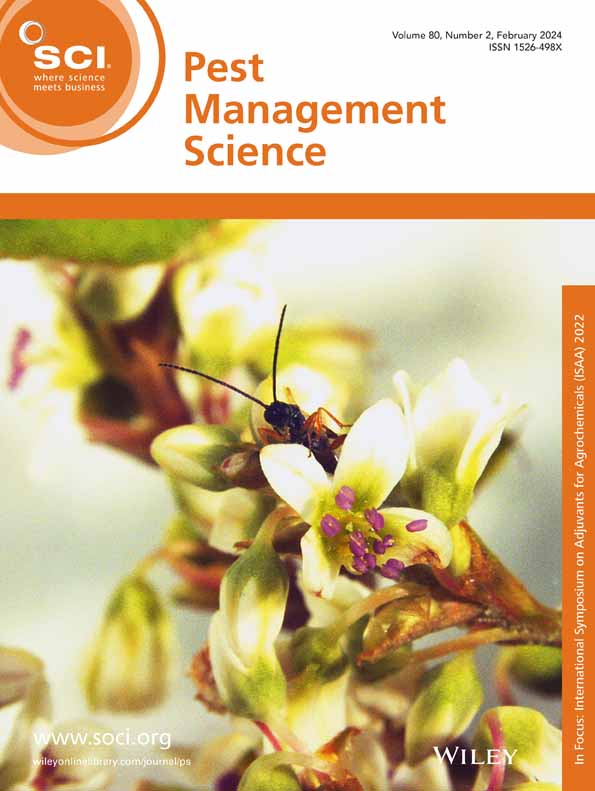使用基于DNA的代谢抗性标记研究暴露于基于吡丙醚的Royal Guard蚊帐对来自喀麦隆的拟除虫菊酯抗性疟疾媒介的长期影响
IF 3.8
1区 农林科学
Q1 AGRONOMY
引用次数: 0
摘要
背景:疟疾病媒对拟除虫菊酯耐药性的不断升级,凸显了采用包含非拟除虫菊酯分子的新控制工具的紧迫性。在这里,我们使用基于DNA的代谢抗性标记,评估了双重活性成分net Royal Guard在喀麦隆对拟除虫菊酯抗性疟疾媒介的功效,确定其对暴露后蚊子生命特征的长期影响。结果皇家卫士对野外按蚊种群的防效较低。但生存曲线分析显示,未暴露的蚊虫寿命(11.4±0.4 d)比暴露的蚊虫寿命(7.9±0.2 d)长(χ2 = 6;P = 0.05),这表明尽管抗药蚊子的即时死亡率较低,但对狐按蚊的寿命有长期影响。高摄食抑制率被观察到(44-80%对11-41%),表明该网对血粉摄取量有负面影响。雌蚊产卵量减少25%,产卵量减少18.30%,产卵量减少8.10%,不育率减少74.74%。关键抗性标记的基因分型显示,代谢标记和L1014F‐Kdrw与药效降低有关,纯合子抗性蚊子比纯合子敏感蚊子更易存活,且暴露后寿命更长(优势比= 15.79;置信区间= 5.35-43.27;P & lt;0.0001)。结论虽然对拟除虫菊酯类杀虫剂产生抗性的蚊子在暴露于Royal Guard杀虫剂后具有更高的生存能力和更长的寿命,但该蚊帐显著影响了它们的寿命和吸血能力,并降低了它们的繁殖力。©2025作者。《病虫害管理科学》由John Wiley &出版;我代表化学工业协会的儿子有限公司。本文章由计算机程序翻译,如有差异,请以英文原文为准。
Long‐term impact of exposure to Royal Guard, a pyriproxyfen‐based bed net, on pyrethroid‐resistant malaria vectors from Cameroon using DNA‐based metabolic resistance markers
BACKGROUNDEscalating pyrethroid resistance in malaria vectors highlights the urgency of implementing new control tools incorporating non‐pyrethroid molecules. Here, using DNA‐based metabolic resistance markers, we assessed the efficacy of the dual active ingredients net Royal Guard against pyrethroids‐resistant malaria vectors in Cameroon, establishing its long‐term impact on mosquitoes' life traits after exposure.RESULTSCone assays revealed low efficacy of Royal Guard against field Anopheles populations. However, analysis of the survival curves revealed that unexposed mosquitoes lived longer (11.4 ± 0.4 days) than those exposed to Royal Guard (7.9 ± 0.2 days) (χ 2 = 6; P = 0.05), indicating that despite the lower immediate mortality observed against resistant mosquitoes, there is a long‐term effect on Anopheles funestus longevity. High blood‐feeding inhibition rate was observed (44–80% versus 11–41%), indicating that this net has a negative impact on blood meal intake. Additionally, female mosquitoes exposed to this net exhibited a 25% reduction in oviposition, 18.30% reduction in fecundity, 8.10% reduction in offspring, and a 74.74% infertility rate compared to the control. Genotyping of key resistance markers revealed that, metabolic markers and L1014F‐Kdrw are associated with the reduced efficacy observed, with homozygote‐resistant mosquitoes significantly more able to survive and live longer after exposure than homozygote‐susceptible mosquitoes (odds ratio = 15.79; confidence interval = 5.35–43.27; P < 0.0001).ConclusionThis study revealed that although pyrethroid‐resistant mosquitoes have higher ability to survive and live longer after exposure to Royal Guard, this net significantly affects their lifespan, blood‐feeding ability and interestingly reduces their fecundity/fertility. © 2025 The Author(s). Pest Management Science published by John Wiley & Sons Ltd on behalf of Society of Chemical Industry.
求助全文
通过发布文献求助,成功后即可免费获取论文全文。
去求助
来源期刊

Pest Management Science
农林科学-昆虫学
CiteScore
7.90
自引率
9.80%
发文量
553
审稿时长
4.8 months
期刊介绍:
Pest Management Science is the international journal of research and development in crop protection and pest control. Since its launch in 1970, the journal has become the premier forum for papers on the discovery, application, and impact on the environment of products and strategies designed for pest management.
Published for SCI by John Wiley & Sons Ltd.
 求助内容:
求助内容: 应助结果提醒方式:
应助结果提醒方式:


